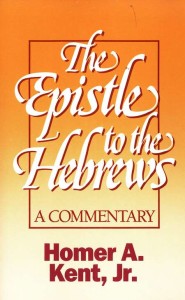Christ’s Presence in Heaven
Hebrews 9:23-28
Therefore there was a necessity on the one hand for the copies of the things in the heavens to be cleansed with these (animal sacrifices), but on the other hand the heavenly things themselves with better sacrifices than these (9:23).
THE NEXT FEATURE OF THE NEW COVENANT’S OPERATION TO BE GIVEN SPECIAL DISCUSSION IS THE FACT OF CHRIST’S PRESENCE IN HEAVEN (VV. 23-28). IS THERE A HINT THAT THE CHRISTIAN TEACHING OF A HIGH PRIEST IN HEAVEN WAS SOMEHOW LESS IMPRESSIVE TO SOME OF THE READERS THAN THE EARTHLY PRIESTS WHO SEEMED MORE ACCESSIBLE? Whether or not such was the case, the importance of Christ’s presence in heaven is set forth in three respects.
FIRST, IT CLEANSED THE HEAVENLY THINGS (VV. 23,24). THE NECESSITY THAT THE EARTHLY SANCTUARY BE CLEANSED WITH THE SACRIFICES MENTIONED ABVOE WAS FOUND IN THE MOSAIC LAW WHICH DEMANDED CERTAIN RITUAL. The tabernacle and its furniture, however, were only copies of the things in the heavens (see 8:5). Whatever cleansing was achieved by the sacrifices offered in the tabernacle was thus performed in a place that was in a certain sense secondary. Now if the earthly sanctuary and practice were a copy, there must be a corresponding need for cleansing in the heavenly counterpart, for the earthly was a copy of some definite thing. The heavenly things themselves surely must be interpreted as the spiritual realities in heaven to which the tabernacle and its ritual gave visible representation. The discussion in 8:1-5 corroborates this view. Since the earthly copies required cleansing by animal sacrifices, surely it is obvious that the heavenly originals needed even better sacrifices than these. Christ’s blood provided this better sacrifice. (the plural sacrifices is used because the statement gives a general principle and is made parallel to the previous clause referring to animal “sacrifices”)
IN WHAT SENSE DID THE HEAVENLY THINGS NEED CLEANSING? PERHAPS THE ANSWER LIES IN THE FACT THAT HEAVEN WAS THE SCENE OF SATAN’S REBELLION, AND THUS NEEDED CLEANSING FROM THE DEFILING EFFECTS OF THAT SIN. One may compare Colossians 2:30, which speaks of Christ’s death as reconciling all things to God, including things in heaven. Another explanation may e that just as the furniture in the tabernacle needed cleansing, not because of itself but because it was the place where sinners were restored to God’s presence, so the heavenly realities, consisting of God’s righteous presence, needed cleansing, not because of sin in heaven but because sinful men used to be reconciled to God’s offended righteousness. What animal sacrifices accomplished ceremonially and typically, Christ’s sacrifice achieved actually. Christ’s blood fully satisfied God’s wrath against sin, and thus His presence in heaven provided an incalculable advance over the ministrations of any earthly priest.
For not into a sanctuary made with hands did Christ enter, a copy of the true one, but into heaven itself, now to appear before the face of God in our behalf (9:24)
IT IS TRUE THAT CHRIST NEVER MINISTERED IN THE TEMPLE IN JERUSALEM NOR IN ANY OTHER SANCTUARY MADE WITH HANDS. HIS TRIBAL CONNECTIONS WOULD HAVE PREVENTED IT (7:13, 14). This is no disadvantage, however; for the earthly tabernacle (and the temples which succeeded it) were but a copy of the true one. As a copy the tabernacle corresponded to the model or pattern (Greek tupon) shown to Moses in the mount (8:5). It was only a copy of representation, not the original.
CHRIST HAS ENTERED HEAVEN ITSELF. THIS IS THE AUTHOR’S DEFINITION OF THE HEAVENLY SANCTUARY. IF HE HAD MEANT FOR HIS READERS TO UNDERSTAND A HEAVENLY STRUCTURE CORRESPONDING TO THE EARTHLY ONE BOARD FR BOARD AND CURTAIN FOR CURTAIN, THIS WOULD HAVE BEEN THE OBVIOUS PLACE TO INDICATE IT. However, heaven itself is the Biblical place of the divine presence, and answers to all the truth conveyed by the symbolism of the earthly holy of holies. It is in the actual and not just the representational presence of God that Christ our high priest has entered now to appear before the face of God. He is not in a smoke clouded chamber where God’s glory needed to be obscured lest the high priest died. He appears in our behalf in the very presence of God, the only place where final priestly representation can be made.
NEITHER (IS IT NECESSARY)THAT HE SHOULD BE OFFERING HIMSELF WHEN, EVEN AS THE HIGH PRIEST ENTERS INTO THE SANCTUARY YEARLY WITH BLOOD OF ANOTHER, SINCE IT WOULD HAVE BEEN NECESSARY FOR HIM TO SUFFER OFTEN FROM THE FOUNDATION OF THE WORLD; BUT NOW ONCE AT THE CONSUMMATION OF THE AGES HE HAS APPEARED FOR (THE) PUTTING AWAY OF THE SIN THROUGH HIS SACRIFICE (9:25, 26)
SECOND, CHRIST’S PRESENCE IN HEAVEN INDICATED THAT SIN HAS BEEN PUT AWAY FOREVER (VV. 25, 26). IT DOES NOT NEED ANNUAL ATONEMENT AS IN THE OLD TESTAMENT SYSTEM. READERS MUST NOT CONCLUDE THAT CHRIST HAS ENTERED HEAVEN IN ORDER TO SECURE ACCESS FOR REPEATED OFFERINGS. His one offering cared for the problem of sin forever. It has been questioned whether this reference to offering himself refers to Christ’s death on earth (cf. vv. 14, 26), or to the presentation of Himself before he Father in heaven, corresponding to the high priest’s entry into the holy of holies (v. 25b). Perhaps it is unnecessary to be so precise. What is paramount in the author’s mind is Christ’s fulfillment of the entire Day of Atonement ritual, and that included both shedding of blood and presentation in the holy of holies. Thus he refers to both the entry into the sanctuary and blood of the sacrificial victim in the same clause.
TO SUPPOSE THAT CHRIST’S PRIESTLY MINISTRY REQUIRED REPEATED OFFERINGS IS TO PRESS THE AARONIC ANALOGYERRONEOUSLY, AND ACTUALLY TO DENY THE BASIC DIFFERENCE IN CHARACTER BETWEEN THE TWO OFFERINGS. In the earthly ritual the blood offered was that of another, being actually the blood of an animal. It was an example and a shadow (8:5) but was not expiatory in itself (9:9; 10:4). To conclude that repeated offerings were still necessary denies the abiding efficacy of Christ’s sacrifice. If Christ’s one offering was not sufficient in itself for the putting away of the sin, then it really accomplished little more than the Old Testament series of sacrifices and needs periodic repetition. If that were the case, Christ should have sacrificed Himself frequently even since the foundation of the world because sin has been a problem since Adam and Eve. Yet this has obviously not happened. God sent His only begotten Son once (hapax), in clear indication that his sacrifice (i.e., Christ’s) was of a character that did not need periodic reoffering to care for all sins since creation. Christ’s sacrifice was made at the consummation of the ages. This designation of Christ’s death uses(communication) to emphasize the focal nature of Calvary. It was the event which was the focus of redemptive history, that in which the various facets of God’s plan of salvation came together. One has expressed it: “All previous ages let up to this: all succeeding ages are governed by this”
THE PUTTING AWAY OF THE SIN WAS THE OVERRIDING PURPOSE OF THE INCARNATION. THE TERM ATHETESIS (PUTTING AWAY) OCCURS ONLY ONE OTHER TIME IN THE NEW TESTAMENT. IT IS USED IN HEBREWS 7:18 OF THE “ANNULMENT” OF THE LAW WHICH WAS NECESSITATED BEFORE CHRIST COULD BE CONSIDERED AS A PRIEST. Thus this debt of sin which holds every man in its grip was fully paid and its penalty is now set aside or annulled for all those who avail themselves of Christ’s sacrifice.
And just as it is appointed for men to die once, and after this (is) judgment, so also Christ being offered once to beat(the) sins of many shall appear a second time apart from sin to those who await for him for salvation (9:27, 28).
THE THIRD SIGNIFICANCE OF CHRIST’S PRESENCE IN HEAVEN IS THAT IT INSURES GOD’S FAVORABLE VERDICT, AND CHRIST’S REAPPEARANCE WILL CONFIRM IT.
JUST AS (KATH HOSON) INTRODUCES AN ANALOGY, ONE DRAWN FROM HUMAN LIFE. IT IS APPOINTED FOR MEN TO DIE ONCE NAMES THE PRINCIPLE IN VIEW. THIS PRINCIPLE HAS ITS EXCEPTIONS; FOR ENOCH AND ELIJAH ESCAPED DEATH, LAZARUS PROBABLY DIED TWICE (HIS RISING BY JESUS WAS APPARENTLY A RETURN TO MORTAL EXISTENCE), AND THE GENERATION OF BELIEVERS WHO ARE LIVING WHEN CHRIST RETURNS WILL NOT DIE AT ALL. Nevertheless, the rule is still normative for human beings. and after this (is) judgment. Death ends man’s opportunity to alter his circumstances. He does not get a second chance, nor die over and over. Death closes the earthly scene for him, and then he must face the eternal issue of his life. This was an important point to remember as these early readers compared Christ’s sacrifice to the Levitical ones. The reason why Christ’s sacrifice does not need frequent repetition as was true of animals in the Old Testament times is because Christ’s sacrifice consisted of Himself (vs. 25). It was a human sacrifice, and men die but once and then must face the results of their lives. inasmuch as this particular human was the God-Man the analogy is all the more forceful.
CHRIST WAS OFFERED ONCE. THE REPETITION OF ONCE (HAPAX) THROUGHOUT THIS CONTEXT SHOWS THE AUTHOR’S E,[JASOS (9:26-28). WERE THE FIRST READERS ENAMORED WITH THE ANNUAL SACRIFICE OF THE JEWISH HIGH PRIEST RATHER THAN WITH THE ONE SACRIFICE OF CHRIST? Once, of course, means “once for all.” Christ’s death brought its irrevocable result. He cannot come to die again. Whatever He achieved by the offering of Himself is finished and settled for all time. His purpose in coming was to bear (the) since of many. The expression seems indebted to Isaiah 53:12. Although His was the death of just one individual, yet it availed – because of who He was – for many others. In actuality, it provided full expiation for all who trust Him for their salvation.
CHRIST’S FIRST COMING WAS AS THE SINBEARER. THE TASK HAS BEEN FINISHED FOREVER. HIS PRIESTLY WORK OF MAKING SACRIFICE IS DONE, AND HIS REPRESENTATION OF BELIEVERS IN THE SANCTUARY OF GOD’S PRESENCE IS NOW BEING ACCOMPLISHED (V. 24). There remains one final action of his high priest. Even as the Jewish priest emerged from the holy of holies, signifying by the very fact of his emergence that his sacrifice had been accepted (otherwise he would have been divinely stricken in the inner chamber), so Christ will appear a second time. Those who await him are all true believers, for whom Christ’s second coming will mean the consummation of their salvation. All of the blessed results of Christ’s sacrifice will be brought to fulfillment. At Christ’s second coming, His purpose will be apart from sin, for that was death with by His once-for-all sacrifice when He came the first time. For believers, salvation in its fullest realization will occur as they share God’s blessed presence for eternity.
THREE “APPEARINGS” OF CHRIST HAVE BEEN MENTIONED IN THESE VERSES. HE NOW APPEARS ON OUR BEHALF IN HEAVEN (V. 24). THIS IS BASED UPON THE PERFECT SACRIFICE OF HIMSELF WHICH HE MADE WHEN HE APPEARED ON EARTH AS THE SINBEARER (V. 26). BELIEVERS NOW LOOK WITH EXPECTANCY TO HIS NEXT APPEARING TO BRING SALVATION TO ITS FULLEST REALIZATION (V. 28). – Kent
Professor Thomas A. Rohm



